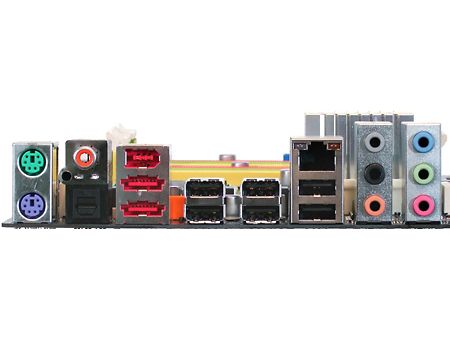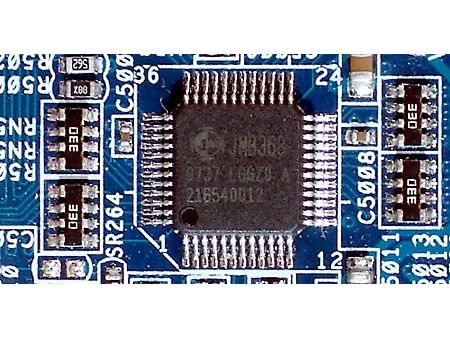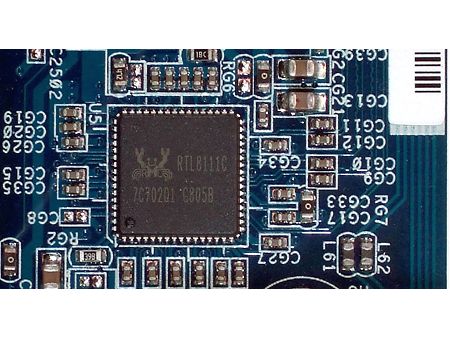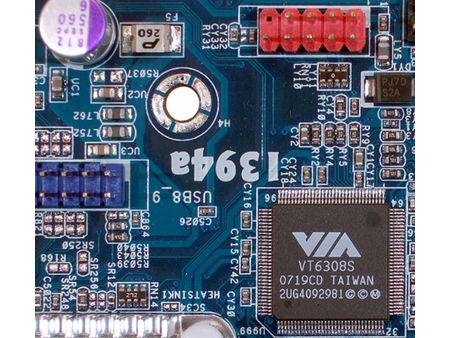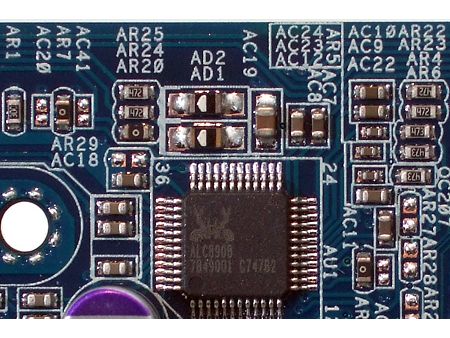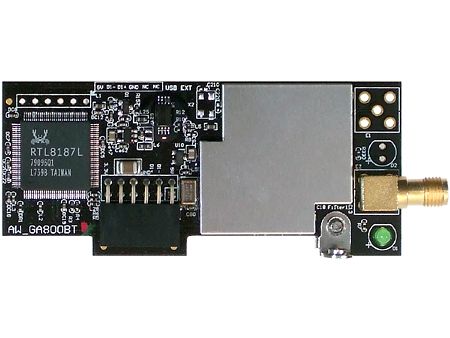X48 Motherboard Comparison, Part 2
Onboard Devices
| Northbridge | Intel X48 Express MCH |
| Southbridge | Intel ICH9R |
| Voltage Regulator | Six Phases |
| BIOS | P1.00 (04/29/2008) |
| 333.3 MHz (FSB1333) | 333.5 MHz (+0.05%) |
| Clock Generator | ICS 9LPRS916JGLF |
| Connectors and Interfaces | Row 6 - Cell 1 |
| Onboard | 2x PCIe x16 |
| Row 8 - Cell 0 | 1x PCIe x1 |
| Row 9 - Cell 0 | 3x PCI |
| Row 10 - Cell 0 | 2x USB 2.0 (2 ports per connector) |
| Row 11 - Cell 0 | 1x IEEE-1394 FireWire |
| Row 12 - Cell 0 | 1x Serial Port header |
| Row 13 - Cell 0 | 1x Floppy |
| Row 14 - Cell 0 | 1x Ultra ATA (2 drives) |
| Row 15 - Cell 0 | 6x Serial ATA 3.0Gb/s* |
| Row 16 - Cell 0 | 1x Front Panel Audio |
| Row 17 - Cell 0 | 1x CD-Audio In |
| Row 18 - Cell 0 | 1x S/P-DIF Out |
| Row 19 - Cell 0 | 1x Fan 4 pins (CPU) |
| Row 20 - Cell 0 | 1x Fan 3 pins (Chassis) |
| IO panel | 2x PS2 (keyboard + mouse ) |
| Row 22 - Cell 0 | 1x RJ-45 Network |
| Row 23 - Cell 0 | 6x USB 2.0 |
| Row 24 - Cell 0 | 2x External SATA* |
| Row 25 - Cell 0 | 1x IEEE-1394 FireWire |
| Row 26 - Cell 0 | 2x Digital Audio Out (S/P-DIF optical + coaxial) |
| Row 27 - Cell 0 | 6x Analog Audio (7.1 Channel + Mic-In + Line-In) |
| Mass Storage Controllers | Row 28 - Cell 1 |
| Intel ICH9R | 6x SATA 3.0Gb/s (RAID 0,1,5,10) |
| JMicron JMB368 PCI-E | 1x Ultra ATA-133 (2-drives) |
| Network | Row 31 - Cell 1 |
| Realtek RTL8111C PCI-E | Gigabit LAN Connection |
| Realtek RTL8187L USB | 802.11g/b Wireless Network Interface |
| Audio | Row 34 - Cell 1 |
| Realtek ALC890B HD Audio Codec | 7.1 Channel Directional Audio |
| FireWire | Row 36 - Cell 1 |
| VIA VT6308S PCI | 2x IEEE-1394a (400 Mb/s) |
ASRock endows the X48TurboTwins-WiFi with a complete controller set typically expected of high-end motherboards, but differs from the norm by using a non-SATA add-in disk controller. Intel chipsets haven’t supported Ultra ATA devices since the P965, and ASRock would have likely left the board devoid of any add-in controller had this not been the case.
The X48TurboTwins-WiFi port panel provides PS/2 keyboard and mouse ports, coaxial and optical digital audio outputs, IEEE-1394 FireWire, six USB 2.0 ports, a single gigabit network port and six analog audio jacks. Two internal SATA to eSATA pass-through connections are also found here, but enabling these requires some very messy internal cabling.
ASRock chose JMicron’s JMB368 Ultra-ATA controller, rather than one that supports both Ultra-ATA and SATA. It uses one of the chipset’s six unallocated PCI-Express pathways to provide optimal performance…typically to slow devices such as a DVD burner.
Realtek’s RTL8111C uses PCI-Express to provide full bi-directional bandwidth to a single Gigabit Ethernet port. The motherboard’s single PCI-Express x1 slot and two third-party controllers use up only three of the chipset’s six “spare” lanes.
ASRock uses VIA’s ancient 6308 series FireWire controller to provide two IEEE-1394 ports. At 133MB/s, its PCI interface is more than fast enough to provide full performance for two 50MB/s (400 megabit) connections.
ASRock is the only company we know of to use Realtek’s ALC890B audio codec, which the company rates at a respectable 110db signal-to-noise ratio.
ASRock continues to use the AW-GA800BT mini-USB card previously found in Asus WiFi products to provide 802.11g/b wireless networking. Realtek’s RTL8187L controller does the job nicely.
Get Tom's Hardware's best news and in-depth reviews, straight to your inbox.
-
nihility I thought the major concern with overclocking was doing it with 4 GB or 8 GB of memory installed and with quad cores.Reply
Buying an overly expensive high end motherboard but installing a 65 nm dual core processor and just 2 GB of RAM seems a very odd combination to me. -
@niReply
Not so odd if you want to get the base foundation set up and then wait for lower prices on higher performance parts later on down the road.
A quad core (3.0 GHz x 4) chip is coming down the pike by years end and DDR3 prices are on the slide. Building an E8400 / 2 GB base machine is exactly what I did to finally migrate from my 5 year old P4 Extreme Edition / Intel 875 based rig.
That's the beauty of the X48 platform; longevity. -
The ECS offering has supposedly been out for around a month, but I can't find it for sale ANYWHERE!! can't even find a price. I used to turn my nose up at ECS products. Our company used Asus boards exclusively thinking they were a higher quality product. Evey one of our Asus boards failed within 4 years. This may be because the Chinese have studied the American business model... Make a product that is designed to either fail or need parts within a calculated period of time. ECS are much cheaper, and so far seem more stable than the Maximus Formula board we purchased recently. The Asus BIOS is for people who like to toy with settings. Unfortunately their BIOS has become complicated beyond their programmers ability too write stable code.Reply
-
Glad to see that gigabyte's board was so much more energy efficient than Asus', or any other board for that matter... especially while overclockingReply
-
Fedor Arcolyte - lol. Did you fall asleep and dream up another page of the review which had power consumption whilst overclocking? :pReply
For the record I'm using my first Gigabyte board (X38-DQ6) and overall I'm pretty happy with it, but having said that I haven't used Asus in at least 5 years. With these comparisons it often comes down to features since performance is pretty near (although the low memory speeds achieved by the Gigabyte surprised me!). -
" Intel covers all of its CPU VRM MOSFET?s with sinks. Our apologies for the alphabet soup that made up the last comment. " -> You could've gone with " Central Processing Unit Voltage Regulator Module Metal?Oxide?Semiconductor Field-Effect Transistor's " , so it's ok =)Reply
-
frodbonzi I wonder how the Asus' Rampage Formula stacks up here? It supports DDR2 or DDR3 and is part of the RoG line... X48 as well...Reply -
xanxaz asrock rocks....lol...although i'll keep my gigabyte... as i dont know where to say this, it's better say it here... your main page is eating my cpu cycles... between 25% up to 50% cpu utilization while viewing your site? please cut down in animated ads... running a c2d at 3.6 and still lags while surfing... dah... it's just your site... os is it me? i think it's the ad on the top right corner that is causing that...Reply -
wozeus I see that Newegg has ECS X48T-A for under $200. Looks like it's a great deal...going to get one.Reply
